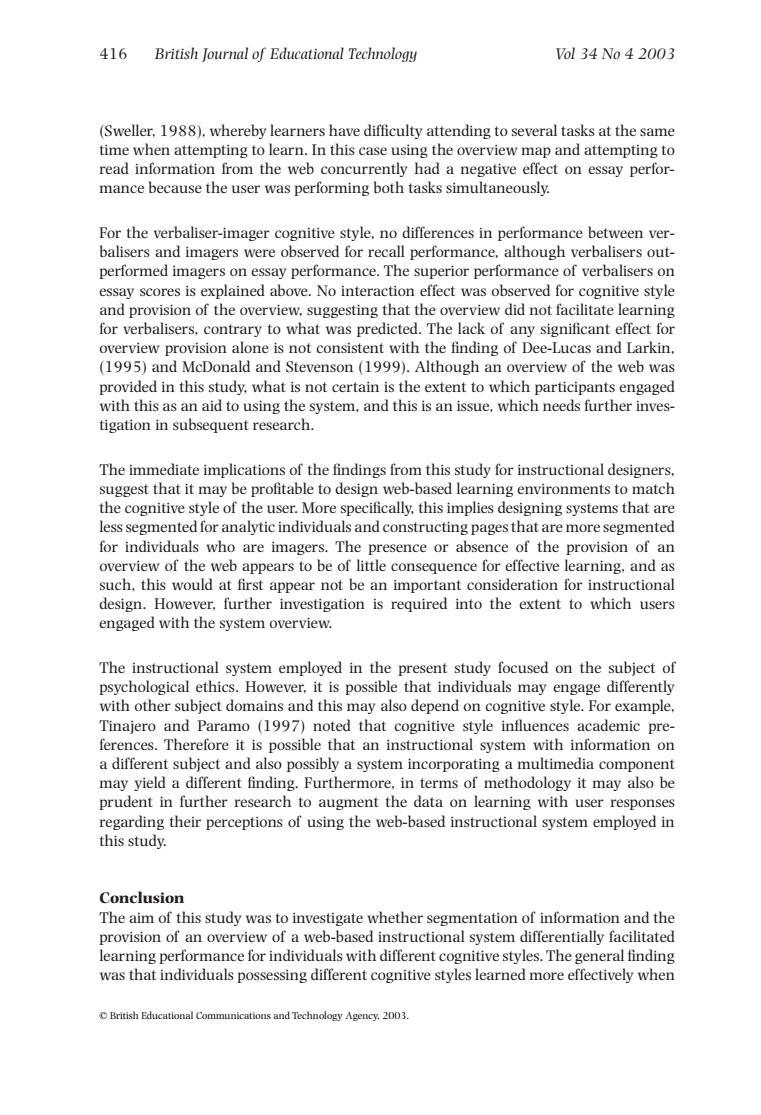正在加载图片...

416 British Journal of Educational Technology al34No42003 (Sweller.1988).whereby learners have difficulty attending to several tasks at the same time when attempting to learn.In this case using the overview map and attempting to read information from the web concurrently had a negative effect on essay per mance because the user was performing both tasks simultaneously. For the verbaliser-imager cognitive style,no differences in performance between ver balisers and imagers were observed for recall performance.although verbalisers out- performed imagers on essay performance.The superior performance of verbalisers on essay scores is explained above.No interaction effect was observed for cognitive style and provision of the overview.suggesting that the overview did not facilitate learning for verbalisers.contrary to what was predicted.The lack of any significant effect for overview provision alone is not consistent with the finding of Dee-Lucas and Larkin. (1995)and McDonald and Stevenson(1999).Although an overview of the web was provided in this study.what is not certain is the extent to which participants engaged with this as an aid to using the system.and this is an issue.which needs further inves tigation in subsequent research. The immediate implications of the findings from this study for instructional designers. suggest that it may be profitable to design web-based learning environments to match the cognitive style of the user.More specifically.this implies designing systems that are less segmented for analytic individuals and constructing pages that are more segmented for individuals who are imagers.The presence or absence of the provision of an overview of the web appears to be of little consequence for effective learning.and as such.this would at first appear not be an important consideration for instructional design.However.further investigation is required into the extent to which users engaged with the system overview. The instructional system employed in the present study focused on the subject of psychological ethics.However.it is possible that individuals may engage differently with other subject domains and this may also depend on cognitive style.For example Tinajero and Paramo (1997)noted that cognitive style influences academic pre- ferences.Therefore it is possible that an instructional system with information on a different subject and also possibly a system incorporating a multimedia component may yield a different finding.Furthermore.in terms of methodology it may also be prudent in further research to augment the data on learning with user responses regarding their perceptions of using the web-based instructional system employed in this study. Conclusion The aim of this study was to investigate whether segmentation of information and the provision of an overview of a web-based instructional system differentially facilitated learning performance for individuals with different cognitive styles.The general finding was that individuals possessing different cognitive styles learned more effectively when o British Educational Communications and Technology Agency.200(Sweller, 1988), whereby learners have difficulty attending to several tasks at the same time when attempting to learn. In this case using the overview map and attempting to read information from the web concurrently had a negative effect on essay performance because the user was performing both tasks simultaneously. For the verbaliser-imager cognitive style, no differences in performance between verbalisers and imagers were observed for recall performance, although verbalisers outperformed imagers on essay performance. The superior performance of verbalisers on essay scores is explained above. No interaction effect was observed for cognitive style and provision of the overview, suggesting that the overview did not facilitate learning for verbalisers, contrary to what was predicted. The lack of any significant effect for overview provision alone is not consistent with the finding of Dee-Lucas and Larkin, (1995) and McDonald and Stevenson (1999). Although an overview of the web was provided in this study, what is not certain is the extent to which participants engaged with this as an aid to using the system, and this is an issue, which needs further investigation in subsequent research. The immediate implications of the findings from this study for instructional designers, suggest that it may be profitable to design web-based learning environments to match the cognitive style of the user. More specifically, this implies designing systems that are less segmented for analytic individuals and constructing pages that are more segmented for individuals who are imagers. The presence or absence of the provision of an overview of the web appears to be of little consequence for effective learning, and as such, this would at first appear not be an important consideration for instructional design. However, further investigation is required into the extent to which users engaged with the system overview. The instructional system employed in the present study focused on the subject of psychological ethics. However, it is possible that individuals may engage differently with other subject domains and this may also depend on cognitive style. For example, Tinajero and Paramo (1997) noted that cognitive style influences academic preferences. Therefore it is possible that an instructional system with information on a different subject and also possibly a system incorporating a multimedia component may yield a different finding. Furthermore, in terms of methodology it may also be prudent in further research to augment the data on learning with user responses regarding their perceptions of using the web-based instructional system employed in this study. Conclusion The aim of this study was to investigate whether segmentation of information and the provision of an overview of a web-based instructional system differentially facilitated learning performance for individuals with different cognitive styles. The general finding was that individuals possessing different cognitive styles learned more effectively when 416 British Journal of Educational Technology Vol 34 No 4 2003 © British Educational Communications and Technology Agency, 2003